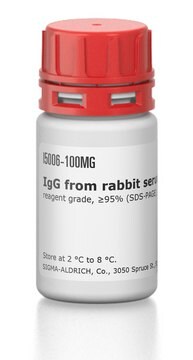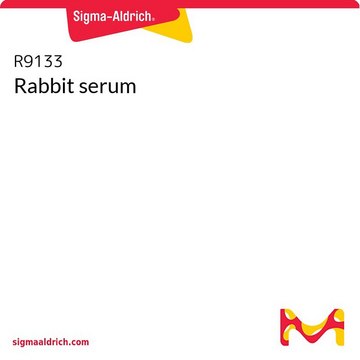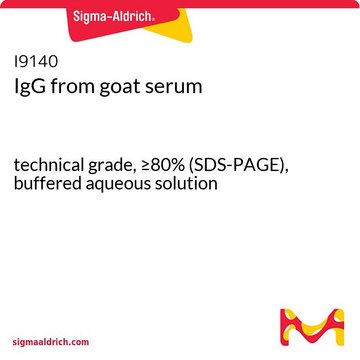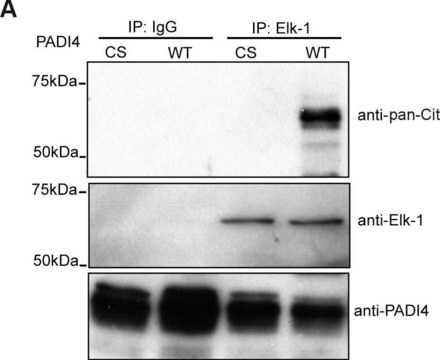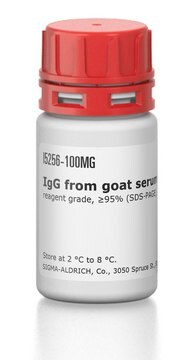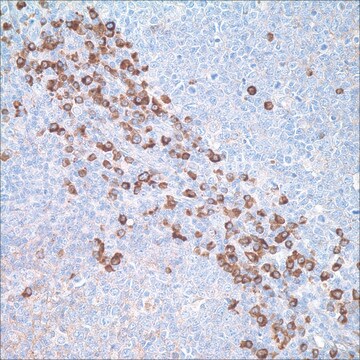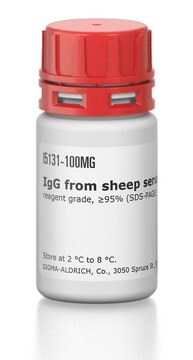I8140
IgG from rabbit serum
technical grade, ≥80% (SDS-PAGE), buffered aqueous solution
Synonyme(s) :
Rabbit IgG
Se connecterpour consulter vos tarifs contractuels et ceux de votre entreprise/organisme
About This Item
Produits recommandés
Conjugué
unconjugated
Niveau de qualité
Qualité
technical grade
Essai
≥80% (SDS-PAGE)
Forme
buffered aqueous solution
Conditions d'expédition
dry ice
Température de stockage
−20°C
Vous recherchez des produits similaires ? Visite Guide de comparaison des produits
Application
IgG from rabbit serum has been used:
- as a reference, standard or blocking agent in many immunoassays including dot blots, ELISA, Westerns, IEP, and immunodiffusion assays
- in arthus reaction
- in chromatin immunoprecipitation
Actions biochimiques/physiologiques
Immunoglobulin G (IgG) regulates the immune responses such as phagocytosis and is also involved in the development of autoimmune diseases. IgG1 regulates complement fixation in mice.
Forme physique
Solution in 0.01 M phosphate buffered saline, pH 7.2, containing 15 mM sodium azide
Notes préparatoires
Rabbit IgG is purified via fractionation from pooled normal rabbit serum
Remarque sur l'analyse
Immunoelectrophoresis (IEP) is used to establish the identity of the Rabbit IgG. . A single major arc of precipitation in the gamma region is observed versus anti-rabbit whole serum and anti-rabbit IgG. Minor gamma arcs may be present versus anti-rabbit whole serum
Clause de non-responsabilité
Unless otherwise stated in our catalog or other company documentation accompanying the product(s), our products are intended for research use only and are not to be used for any other purpose, which includes but is not limited to, unauthorized commercial uses, in vitro diagnostic uses, ex vivo or in vivo therapeutic uses or any type of consumption or application to humans or animals.
Code de la classe de stockage
12 - Non Combustible Liquids
Classe de danger pour l'eau (WGK)
WGK 2
Point d'éclair (°F)
Not applicable
Point d'éclair (°C)
Not applicable
Faites votre choix parmi les versions les plus récentes :
Déjà en possession de ce produit ?
Retrouvez la documentation relative aux produits que vous avez récemment achetés dans la Bibliothèque de documents.
Les clients ont également consulté
Valérie Bardet et al.
Haematologica, 91(6), 757-764 (2006-06-14)
Abnormal activation of several signal transduction pathways such as phosphoinositide 3-kinase (PI3K) and MAP kinases has been reported in acute myeloid leukemia (AML). To test new targeted therapeutics, it is critical to develop sensitive analytical tools to detect abnormal activation
Frances Rena Bahjat et al.
Arthritis and rheumatism, 58(5), 1433-1444 (2008-04-29)
To assess whether R788, an orally bioavailable small molecule inhibitor of spleen tyrosine kinase (Syk)-dependent signaling, could modulate disease in lupus-prone (NZB x NZW)F1 (NZB/NZW) mice via inhibition of Fc receptor (FcR) and B cell receptor signaling. R788 was administered
Janus Schou Jakobsen et al.
Genome research, 23(4), 592-603 (2013-02-14)
Dynamic shifts in transcription factor binding are central to the regulation of biological processes by allowing rapid changes in gene transcription. However, very few genome-wide studies have examined how transcription factor occupancy is coordinated temporally in vivo in higher animals.
Elena Matveeva et al.
Cell discovery, 2, 15046-15046 (2016-07-28)
Specialized chromatin structures such as nucleosomes with specific histone modifications decorate exons in eukaryotic genomes, suggesting a functional connection between chromatin organization and the regulation of pre-mRNA splicing. Through profiling the functional location of Poly (ADP) ribose polymerase, we observed
Lily Chien Wang et al.
DNA repair, 7(12), 1973-1981 (2008-09-13)
Fanconi anemia (FA) is a recessive genetic disorder characterized by hypersensitivity to crosslinking agents that has been attributed to defects in DNA repair and/or replication. FANCD2 and the FA core complex bind to chromatin during DNA replication; however, the role
Notre équipe de scientifiques dispose d'une expérience dans tous les secteurs de la recherche, notamment en sciences de la vie, science des matériaux, synthèse chimique, chromatographie, analyse et dans de nombreux autres domaines..
Contacter notre Service technique